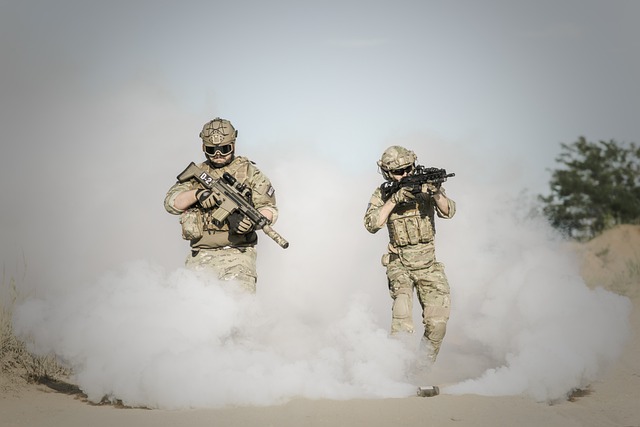A siege is a long-term strategy of cutting off a target from resources and reinforcements while an assault is an immediate attack against it. While sieges are used mostly to weaken or force surrender from the enemy, assaults are more direct attacks with the goal of quickly taking over or destroying the target.
What is a siege?
A siege is a military tactic in which an armed force surrounds and isolates a fortified location, such as a city or a fortress, with the intention of cutting off its supply lines and forcing its surrender. The goal of a siege is to wear down the defenders through starvation, disease, and psychological pressure, rather than through direct military confrontation.
During a siege, the besieging force may construct fortifications, such as walls or trenches, to prevent the defenders from escaping or receiving supplies. They may also use various weapons and tactics, such as artillery bombardment or tunneling, to breach the defenses of the besieged location.
A siege can last for days, weeks, or even months, and can be a brutal and harrowing experience for both the attackers and the defenders. Siege warfare has been used throughout history, from ancient times to modern warfare, and has been responsible for some of the most famous military campaigns and battles.
What is an assault?
(Image by Dariusz Sankowski from Pixabay )

assault usually refers to a military operation in which a ground force attacks and overcomes an enemy position or stronghold. It involves a coordinated attack by infantry, armored vehicles, and artillery, often supported by air power, to breach the enemy’s defenses and capture or destroy their objectives.
Assaults in war can take many forms, including frontal assaults, flanking attacks, and infiltration operations. They require careful planning, preparation, and execution, and can involve significant risk to the attacking force. Assaults can be launched in both offensive and defensive operations, and are a critical component of modern warfare.
Assaults in war can be highly intense and violent, with heavy casualties on both sides. They can also involve the use of various weapons and tactics, including grenades, rockets, and other explosives. Despite the dangers and risks involved, successful assaults are often crucial to achieving strategic objectives and securing victory in a military campaign.
Types of Sieges
Blockade Siege: In this type of siege, the attacking army blocks all sea and land access to the besieged city or fortress. This cuts off all supplies and prevents any reinforcements from reaching the defenders.
Investment Siege: This is a type of siege in which the attacking army completely encircles the enemy stronghold, preventing any escape or resupply attempts. This type of siege is used to starve the enemy out and force them to surrender.
Blockade and Investment Siege: This type of siege combines the features of both the blockade and investment sieges. The attacking army both blocks all access to the besieged city or fortress and completely encircles it, cutting off supplies and preventing any escape or resupply attempts.
Contravallation Siege: This is a type of siege in which the attacking army builds a line of fortifications around the besieged city or fortress to prevent the defenders from breaking out. This type of siege was common in ancient times, when cities were often fortified with walls.
Circumvallation Siege: This is a type of siege in which the attacking army builds a line of fortifications around their own forces, to protect themselves from any relief forces that might attempt to break the siege. This type of siege was also common in ancient times.
Each type of siege has its own advantages and disadvantages, and military commanders will choose the best strategy based on the strength of the enemy position, the terrain, and the objectives of the mission.
Types of assaults
Direct Assault: This is a frontal attack in which a military force attacks the enemy’s position head-on, with the goal of overwhelming and capturing or destroying the position. Direct assaults can be very risky, as the attacking force is exposed to enemy fire and can suffer heavy casualties.
Flanking Assault: This is a type of attack in which a military force attempts to outflank the enemy by attacking from the side or rear. Flanking assaults are designed to catch the enemy off-guard and disrupt their defensive posture.
Infiltration Assault: This type of assault involves sending small groups of soldiers or special forces behind enemy lines to conduct sabotage or reconnaissance missions. Infiltration assaults are often used to gather intelligence or weaken the enemy’s defenses before a larger assault is launched.
Air Assault: This is an assault that is conducted by airborne troops or by helicopter-borne troops. Air assaults can be used to quickly deploy troops behind enemy lines or to support a ground assault with air power.
Naval Assault: This is an assault that is conducted by naval forces, usually to capture a beachhead or coastal position. Naval assaults can involve amphibious vehicles, landing craft, and naval gunfire support.
Each type of assault has its own advantages and disadvantages, and military commanders will choose the best strategy based on the terrain, the strength of the enemy position, and the objectives of the mission.
The Difference Between a Siege and an Assault
When it comes to military terms, the difference between a siege and an assault can be confusing. Both involve large-scale attacks on enemy strongholds, but there are some key distinctions.
A siege is a prolonged attack on a fortified position, typically involving encirclement and cutting off supplies. The goal is to force the occupants to surrender. Sieges can last for weeks or even months, as was the case with the famous Siege of Trenton during the American Revolution.
An assault, on the other hand, is a more direct attack aimed at breaching defenses and taking control of the stronghold. Assaults are often over in a matter of hours or days, as was the case with the Battle of Normandy during World War II.
So which one is worse? That depends on your perspective. For the defenders, a siege can be incredibly frustrating and taxing, not to mention deadly if supplies run low. For the attackers, an assault can be extremely risky and costly in terms of lives lost.
Famous Sieges in History
There have been many famous sieges throughout history, some of which have gone down in infamy. Here are a few famous examples:
The Siege of Troy: This was one of the most epic battles ever fought, lasting for 10 years. The city of Troy finally fell when the Greeks were able to sneak inside the city using the Trojan Horse.
The Siege of Jerusalem: This was another lengthy battle, lasting for several months. Ultimately, the Romans were successful in breaching the city walls and captured Jerusalem.
The Siege of Leningrad: This was one of the deadliest sieges of all time, lasting for over 800 days. Over 1 million people died during this siege, which was finally broken by Soviet forces.
What is the difference between attack and assault?
In general, both “attack” and “assault” refer to an act of aggression or violence. However, in some contexts, the terms may have specific legal or military meanings, which can affect their usage. Here are some general differences between the two terms:
Scope: “Attack” is a more general term that can refer to any act of aggression, whether it is physical or verbal. “Assault,” on the other hand, typically refers to a physical attack or threat of attack that causes fear of harm or injury.
Severity: “Assault” typically implies a more severe level of violence or aggression than “attack.” In legal contexts, an assault charge may be more serious than a simple battery charge.
Legal Context: In some legal contexts, “assault” may have a specific legal meaning that is distinct from “attack.” For example, in some jurisdictions, assault is defined as the threat of physical harm, while battery is the actual physical contact.
Military Context: In military contexts, “assault” often refers to an offensive operation designed to capture an enemy position, while “attack” can refer to any act of aggression or violence.
When should d attack and siege be used?
The decision to use either an attack or siege strategy depends on various factors such as the strength and weakness of the opponent’s position, the objective of the mission, the terrain, and available resources. Here are some factors to consider when deciding whether to use an attack or siege strategy:
Strength of the enemy position: If the enemy is well-fortified with strong defenses, a direct attack may be difficult and costly in terms of resources and lives lost. In such situations, a siege may be a more effective way of forcing the enemy to surrender or weaken their defenses.
Objective of the mission: If the objective is to capture or destroy a specific target, such as a bridge or military installation, an attack may be the best option. On the other hand, if the objective is to starve the enemy out or force them to surrender, a siege may be more effective.
Terrain: The terrain can affect the success of both attack and siege strategies. For example, attacking across difficult terrain, such as mountains or dense forests, can be challenging and may result in high casualties. In contrast, a siege can be more effective in areas with favorable terrain, such as flat open fields.
Available resources: The decision to use an attack or siege strategy may depend on the resources available to the attacking force. For example, if the attacking force has limited supplies or troops, a siege may be the only viable option.
The decision to use an attack or siege strategy depends on a variety of factors, and military commanders must carefully weigh the risks and benefits of each option before making a decision.
Featured Images By – Image by ThePixelman from Pixabay








